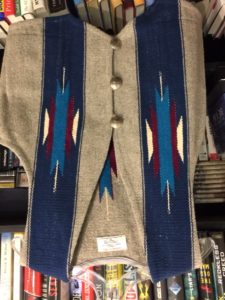 GM, who works at a local secondhand store, offers plenty of Fiesta Costumes for sale as I write this. A Rio Grande Vest at the shop evokes the Spanish Colonial traditions we all celebrate with our Fiesta events. The shop puts out Spanish flavored textiles for Fiesta every year. GM wonders about Spanish style textile weavings, and their values.
GM, who works at a local secondhand store, offers plenty of Fiesta Costumes for sale as I write this. A Rio Grande Vest at the shop evokes the Spanish Colonial traditions we all celebrate with our Fiesta events. The shop puts out Spanish flavored textiles for Fiesta every year. GM wonders about Spanish style textile weavings, and their values.
The story tells of domination of powers that resulted in a style of Southwest weavings identified forever as Mexican style. Oddly, the style originated outside of Mexico, and by extension, outside of Spanish craft arts. The style originated with the New Mexico weavers, Native American textile artists, pre-colonization.
A misnomer, the style we refer to as Spanish Colonial Fiber art possesses a history much older than the arrival of the Spanish to North America. Thousands of years of weaving occurred before the first Spanish arrivals in the 15th century to the Southwest regions.
The Native Americans perfected textile weavings in fibers as distinct as human hair, dog fur, and native plant materials. Mats, clothing, and vessels, all woven of this study stuff. Native American discovered how to train cotton crops to accept high altitudes and short growing seasons, and then they developed a portable loom on which to weave cotton.
Cotton became the secondary material for weavers, who for centuries mixed cotton with other fibers. Although we think of sheep and their wool as native to the West, Juan de Onate (1598) brought Mexican settlers to parts of New Mexico, along with the wool–producing Churro sheep. Thus for the next 300 years, Native American weavers fought to maintain a style of weaving supplanted by wool. The Spanish introduced the European treadle loom designed FOR woolen weaving.
The Spanish forced Native American weavers to learn and labor. The Colonists opened the first textile ‘factory’ in Santa Fe in 1638, which exported weavings back to Mexico City.
GM’s little woven vest tells such a tale of strife
Native American workers wove this vest out of wool, the textile of choice for Spanish colonial export, on a European style loom. They longed for their own cotton and their own looms. This lead to a bloody revolt, but Spanish dominance resumed in 1694, establishing wool as the dominant fiber for Spanish colonial textiles.
A forced blending of two cultures resulted in the Rio Grande style of woolen ornamentation we see on GM’s vest. In 1790, colonists sent two master weavers from Mexico City to instruct and rule over the Native American weavers. They established a center for weaving wool in Albuquerque.
Mexico City loved the style.
In the 50 years which followed, colonists exported 20,000 pieces (rugs, mats, and serapes) to Mexico City.
The railroad and the development of the tourist market became another outside influence. When we think a souvenir of a trip always existed as a concept, the idea of bringing home something culturally distinctive (and affordable) originated with the coming of the railroad. The famed Chimayo textile industry emerged out of supplying local trading posts with Southwest blankets, collected by tourists.
GM’s vest from the mid-20th century resulted from cultural cross currents interpreted on textiles for at least eight generations in the Chimayo Rio Grande style. We think of these woolen vests, serapes and blankets as Mexican, and by extension Spanish Colonial, but no. The fabric art, those saltillos and triangles, stripes and stars, woven on the two harness walking loom, was a product MADE for import TO Mexico and Spain by Native American weavers in New Mexico, under Colonial domination.
A 19th century vest like GM’s might go for $2,000. Silver buttons, coins pounded into roundness, are a telltale mark of an older piece of Rio Grande weavings. But GM’s vest is mid-20th century, signally the re-awakening of a craft tradition on the brink of extinction, due to the homogeneity of clothing styles and the demands of a mass market for cheaply made woolen blankets and coats in the late 19th early 20th centuries. The generation that brought us “counter – culture,” the kids of the 1960’s, who wore ethnic clothing as a badge of difference rediscovered this style. GM’s vest is worth $200.